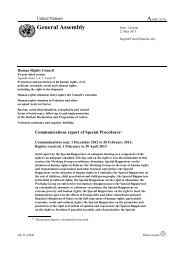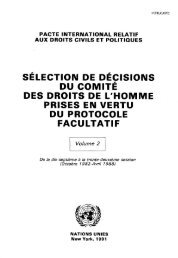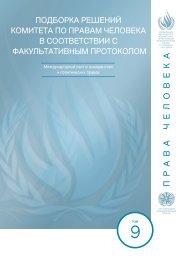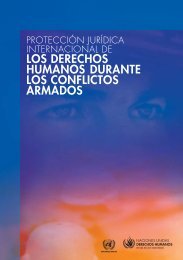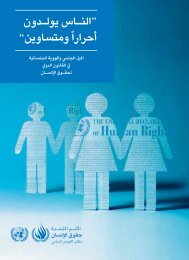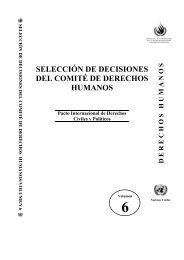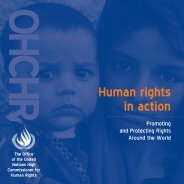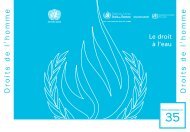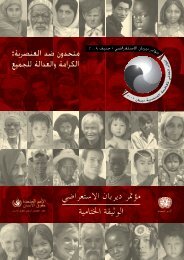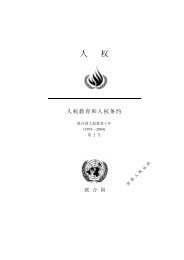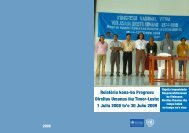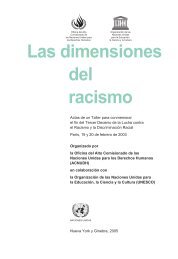good governance practices for the protection of human rights
good governance practices for the protection of human rights
good governance practices for the protection of human rights
You also want an ePaper? Increase the reach of your titles
YUMPU automatically turns print PDFs into web optimized ePapers that Google loves.
• Creating multi-agency partnerships and facilitating discussion among<br />
stakeholders in order to promote social change (Uganda, Jordan and<br />
Ecuador).<br />
• Raising public awareness and sharing in<strong>for</strong>mation with <strong>the</strong> public on public<br />
policies and <strong>human</strong> <strong>rights</strong> principles (Uganda and Ecuador).<br />
A. Education services adapted to <strong>the</strong> needs <strong>of</strong> <strong>the</strong> rural poor – Uganda<br />
Issue<br />
The Karimojong are a semi-nomadic, pastoral people living in north-east Uganda.<br />
There are about 640,000 Karimojong living in <strong>the</strong> region. The region is <strong>the</strong><br />
poorest in Uganda and is plagued by conflict and poor social indicators, including<br />
low school attendance and very low literacy rates <strong>of</strong> 12 per cent <strong>for</strong> men<br />
and 6 per cent <strong>for</strong> women. The Ugandan Government’s 1997 Universal Primary<br />
Education Programme led to an increase in primary school enrolment in many<br />
regions, but not in Karamoja.<br />
The Karimojong children’s right to education, including access to primary education,<br />
was not guaranteed as parents routinely discouraged school attendance.<br />
Fur<strong>the</strong>rmore, girls faced discrimination in accessing basic education as fewer<br />
girls attended school than boys.<br />
Response<br />
The Alternative Basic Education <strong>for</strong> Karamoja (ABEK) programme, launched in<br />
1998, recognized that <strong>the</strong> <strong>for</strong>mal education system was incompatible with <strong>the</strong><br />
Karimojong nomadic lifestyle and <strong>the</strong> community’s reliance on children’s participation<br />
in household work. An education programme which was culturally<br />
adaptable and would bridge <strong>the</strong> gap between <strong>the</strong> delivery <strong>of</strong> <strong>for</strong>mal education<br />
and <strong>the</strong> Karimojong lifestyle was needed.<br />
Design<br />
The preparation <strong>for</strong> an alternative education programme <strong>for</strong> <strong>the</strong> Karimojong began<br />
in 1995 as a result <strong>of</strong> a partnership between <strong>the</strong> Ministry <strong>for</strong> Karamoja Affairs,<br />
Save <strong>the</strong> Children Norway and <strong>the</strong> district education <strong>of</strong>fices <strong>of</strong> Moroto and<br />
Kotido. As a first step, Save <strong>the</strong> Children and <strong>the</strong> district <strong>of</strong>fices held consultations<br />
in <strong>the</strong> local communities in order to identify local attitudes towards education in<br />
general and <strong>the</strong> education system in particular. The consultations confirmed that<br />
<strong>the</strong> Karimojong associate education with State-sponsored harassment. They also<br />
regard <strong>the</strong> education system as irrelevant to <strong>the</strong>ir survival needs both because it<br />
withdraws children from <strong>the</strong> sphere <strong>of</strong> economic activity and because it fails to<br />
provide children with skills <strong>the</strong>y consider useful to life in Karamoja.<br />
The consultations also revealed that, despite <strong>the</strong>ir scepticism towards outsiders<br />
and <strong>for</strong>mal education, <strong>the</strong> Karimojong valued both traditional and modern<br />
30



